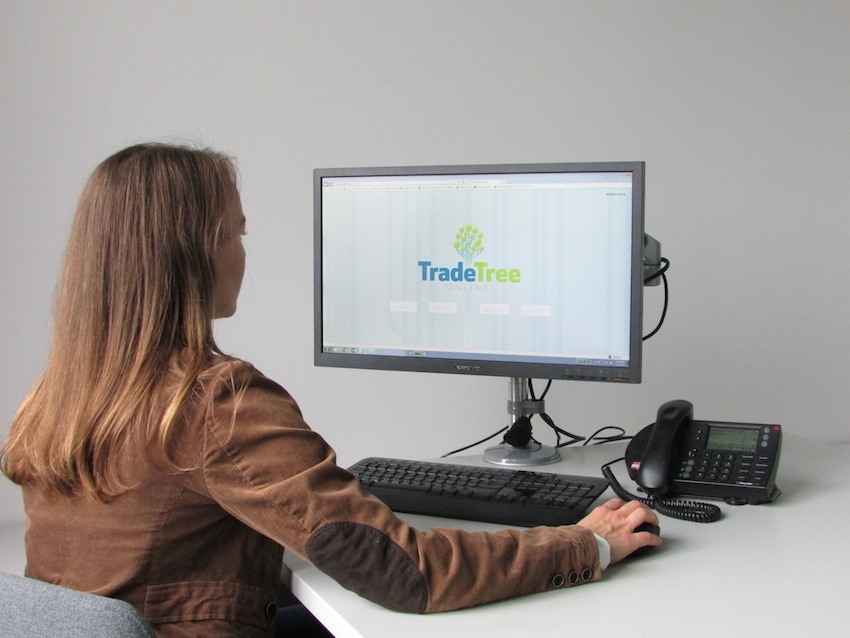
Features
Financial Reports & Markets
Pulp
Tracking price movements in the pulp market
Participation is growing in an independent platform designed to confidentially aggregate spot pulp price movements into reference price indices
January 29, 2018 By Treena Hein

Jan. 29, 2018 – By now, you will have likely heard about the global pulp price indices and trading platform called Trade Tree Online (TTO). Founded in May 2016 by Brian McClay and Fraser Hart, TTO is an independent company that turns verified spot pulp price movements into reliable reference price indices. It collects monthly spot pricing data from market participants in a standardized and consistent manner and then confidentially aggregates this pricing to generate volume weighted-average, transactions-based indices.
McClay, who serves as TTO chair, is principle at Montreal-based Brian McClay & Associates market intelligence consulting firm. Meanwhile, Hart most recently held the position of director of sales, North America Pulp at Resolute Forest Products.
“Our index launched in May 2016 and we have been very successful at recruiting an increasing number of pricing data providers since then,” says Hart, TTO managing partner. “Our goal was to create reliable, transparent and transaction-based indices that properly track the market. Most commodities traded on a regulated exchange have a cash market which sets the price for the overall market. For pulp, that is the spot market and for TTO, it is these market-based transactions that drive our indices. Moreover, our trading platform is designed to increase the efficiency of the spot market by making it easier and more transparent to reach a much wider marketplace.”
Hart says the TTO platform also facilitates the more efficient exchange of commercial information, like product specifications, documentation requirements and other important information like environmental, safety and sustainability certifications.
It took more than a year to sketch out and develop the initial concept for the TTO indices and platform, and the team continues to refine and enhance them to meet the needs of market participants. “We continue to add capabilities to the site and market coverage of the indices,” Hart says. “We’ve had very useful feedback, advice and support from market participants and we continue to listen and evolve.”
Successfully implementing innovative systems of this complexity in a traditional industry like pulp has come with challenges. One hurdle centred on the need to provide transparency and accurate price movements without divulging sensitive underlying transaction information. “This is why TTO features an index rather than a dollar-based system,” he explains. “We’ve also developed innovative solutions to ensure the TTO model factors out the effects of differing shipping locations and quality differences between pulps.”
Another challenge is resistance to change. “While people are aware of some of the flaws of the current list price system, it takes time to get comfortable with another way of doing things,” Hart observes. “But just as it has done in many other industries, technology and better measurement has the potential to drastically improve performance. We’ve seen a dramatic shift toward technology and measurement tools in other areas of the pulp business, but it’s amazing how much of the commercial side of the business has relied on anecdotal pricing information and hearsay.”
The fact that 2017 has been a very unusual year for pulp markets, with almost unprecedented price volatility, brings another challenge. “I think there is a contingent of market participants that need to see the new TTO indices moving through different market cycles before they trust it fully,” he says. “We’re confident that over time the TTO model will prove to be highly accurate, robust and reliable.”
Futures market to come
The TTO team believes the creation of independent and reliable price indices will finally provide the basis for a viable financial futures market for pulp, which will come after a number of failed past attempts by various parties.
“Those models were typically based on anecdotal list price indices,” explains Sean Curran, industry consultant and TTO board member. His previous roles include senior vice-president positions with Catalyst Paper and Canfor. “TTO is based on net pulp prices from auditable transactions consistent with objective data collection principles.” He says that with TTO’s use of spot prices only, its indices can act as a clear point of reference for any physical or financial futures contracts, as they do for other commodities.
Curran says, that overall, TTO’s systematic approach takes the guessing and emotion out of the market, and he believes its independence and reliability should attract more interest in transacting from third-party financial parties, not just traditional pulp industry buyers and sellers. Additionally, he says the development of a financial futures market for pulp will enable sellers and buyers to better de-risk through more reliable hedging programs. “We believe that one of the critical components to a thriving futures market is an active and transparent cash market,” Hart adds. “We believe that with TTO capturing auditable pricing information from a robust and transparent spot market, that more entities in the pulp business and beyond will reference TTO for both financial and physical transactions.”
Hart says that having a transparent way for setting prices will avoid conflict between buyers and sellers, as well as minimize antitrust issues. Spot markets work very well at price discovery, he explains, and when they’re open and transparent, they can resolve a lot of the market participant conflict and inefficiency.
An inefficient pricing environment will lead the inefficient supply allocation, which hurts sellers in the form of lower mill-nets and buyers in the form of higher prices.
“For years, the pulp and paper industry has complained about the opaqueness and unsystematic approach of traditional pulp and paper price index providers,” notes Curran. “I’ve heard thousands of comments like ‘We don’t trust the info going into the data. Who are they talking to? Do they adjust for volume and location?’ The polling size is too narrow and changes month-to-month. TTO’s approach avoids all of this uncertainty.”
Hart agrees. While it will take a bit of effort for people to find the time to learn about TTO’s new system, he says it will be worth it. Hart adds that as new members join the industry, TTO will help them look at things differently.
“That will also help with large-scale adoption,” he says. “We need strong leadership and vision from some of the more forward-thinking and dynamic companies in the industry. Companies that are willing to learn and adapt to new ideas and technology such as this are going to have a huge advantage, as they always have.”
Since its inception, TTO has published monthly price indices for NBSK, SBSK and BHK in North America. It launched a China NBSK index at the end of 2017, and plans to launch several others this year.
This feature was originally published in the Winter 2018 issue of Pulp & Paper Canada.
Print this page


